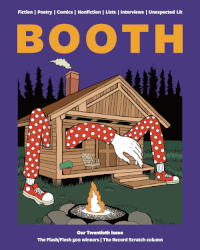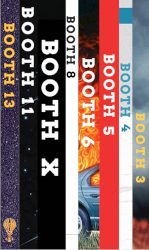AM: Do you work on multiple projects at once? Like, if you’re working on a novel, will you also have short stories going?
JL: It ends up being that way, but you’re not really writing more than one thing at a time, you’re just switching back and forth. And it’s costly. When you’re doing that switching, energy is lost, so I try not to. I’m often backed into it by promises I’ve made to myself or someone else, or life plans changing slightly. Books get interrupted in favor of this or that short thing, but the best of all is to do one thing until it’s done.
AM: At what point do you decide something is ready to show someone else?
JL: There’s one type of showing that I often do when something is not ready. At some point medium-early in a project I need to throw a lifeline out from my own anxieties, so I get someone to read it to say “You’re onto something, now get back to work.” So there’s one type of reading that has to do with a book not being ready, but with me needing a pat on the back. But after that, I don’t really like to show unfinished work. I like to get it to where I think it’s going to knock people out of their shoes, and then deliver it, make it a fait accompli.
AM: How do you develop that internal set of tools to see problems in your own work?
JL: It’s a corner you turn, and it happens usually in the course of workshopping or writer’s group or some even less formal version of finding devoted early readers that you begin to see through a potential reader’s eyes, and you can be honest with yourself about how much of your original intention was achieved on the page. It’s never instantaneous—there are lots of scenes I’ve written where I was sure I carried it off brilliantly the first time through, and that feeling persists as a kind of obscuring of what’s really on the page. And then the time comes when I read it and I see, oh, seventy-five percent of my intention is there. Then I grumble and go back to make it right.
AM: Do you revise daily?
JL: I do end up reworking stuff every time I write, as well as writing new stuff every time I write. Nowadays that’s mostly how I work. So in a sense, where once upon a time I’d have written a fast first draft and then a full second draft, I now have a slower pace through the first time, but it might be described as a kind of first and second draft combined. Then comes the setting-aside, and reconsideration, and a genuine, full revision. But the computer has changed the way everyone writes.
I’m a living bridge to this other time. I wrote my first three novels on typewriters. So a second draft was a draft—you rolled a fresh sheet of paper into the machine, and made new contact with every word. Every word and every decision had to pass again through your fingers to make it into the second draft. Well that’s a very strong learning tool. Sometimes I will ask my writing students to print out a draft and delete the file. Put the draft on your desk and open a new document and make your draft a draft. Rewrite the whole thing. Look at the page and ask, does this sentence deserve to go from this pile of paper back onto my computer? And I’m sure that anyone who’s ever followed my advice has had great breakthroughs, but probably no one ever does.
AM: Would you recommend the same thing with short stories?
JL: Sure. If you’re afraid of doing it for a novel, do it for a short story. You’ll learn from totally tearing it down, and building from the ground up.
AM: I’m kind of reeling a little now, because it makes me wonder what might be lost by computers. It must completely change the way fiction is made.
JL: I think it changes a lot. I don’t mean that the best books, or the most realized writing is in some essential way different than it would have been without computers. The end result is probably fairly similar. But the way people are getting where they’re going has fundamentally changed, because of the fact that your text is committed in this endlessly mutable, watery medium, where you can fidget around with it all the time. With typewriters, if you typed a paragraph with a ribbon and ink, then it was typed. You had a few really clumsy options. You could use white out, you could go XXX for a few sentences, or you could pull out a pen and write words above the typewritten font. It was like you were carving in a physical substance.
I revised one of my books with scissors and glue. I would cut paragraphs out of the paper, and sometimes sentences. I would have these ribbons of words I would be pasting onto the page in different places. But now we carve in air. We carve in ether. It makes some things much easier, but it makes other things invisible. There are things that are never confronted or encountered because you’re not handling them in a more material way. You can wave your hand and just make them fly through the air.
AM: When you’re writing, do you start with characters in mind?
JL: I usually have simultaneous and wedded inklings of characters and problems, a situation or milieu. The characters don’t just exist the way a costume designer draws a character on the page, in white space. Usually to be interested in the character you’re already connecting them to some situation or dynamic involving other characters.
AM: Fortress of Solitude starts in third person and then goes into first person. The reader gets a different feel for the character that way. Was that the point?
JL: For better or worse it was always the plan – it was how I saw the book from the outset. The first half would be omniscient and multi-vocal. You’d get to meet a lot of different characters through third person subjective, and you would only know the primary character in those terms, and see him in his world. And then there would be this harshness of the experiences of having his world fall away, and you and he would be stranded together in adulthood. I wanted to create something structural in the book that was analogous to the giant gulf created between childhood and adulthood, which was one of my subjects in the book. So the shift was a way to create a distressing pothole in the middle that you had to jump over in order to continue with Dylan as a character.
And he’s distressing to meet in first person. He’s mean, and small-hearted.
AM: Was that difficult to write?
JL: That whole book was exhilarating to write, because I was working over my head the whole time. The plan seemed audacious to me, but I felt at the time that I was ready to make this incredible thing come to life, and that I was doing it, even as I wrote the most painful material… whatever else it was, it was also exhilarating. The overwhelming feeling was of empowering myself to give names to things that didn’t have names, and to put my imprimatur on all this chaos of experience and longing and shame and confusion that had been out of control until I took command of it.
AM: When you say ‘give names to things,’ you’re not talking just socially, but also personally?
JL: All of the above. The whole footing of that project was to be as overt and extensive in naming the unnamable, talking about the shameful or the unspoken stuff of that life that I was a part of in Brooklyn. I wanted it to be a book about embarrassment, and I wanted it to be embarrassing to read. I wanted it to feel, by the end, that something extensively secret had been extensively unveiled.



